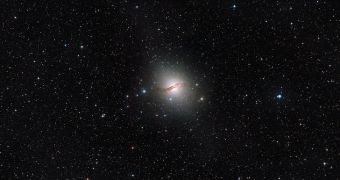A paper published in yesterday's issue of the Astrophysical Journal documents the use of the Hubble Space Telescope to gain a better understanding of the anatomy of an elliptical galaxy known to the scientific community as Centaurus A.
The galaxy was discovered back in 1826, and is estimated to sit at a distance of over 13 million light-years from our planet. As detailed by astronomers, this distant elliptical galaxy also goes by the name of NGC 5128.
Writing in the Astrophysical Journal, scientists with the Hubble Information Center explain that, according to previous investigations, galaxies like Centaurus A and even our Milky Way comprise more than just a core and arms.
Thus, they also have a so-called halo of distant stars that is their most remote part and whose makeup offers glimpses into how one galaxy or another came into being and how its makeup and appearance have changed over the years.
It is precisely this starry halo at the edge of Centaurus A that astronomers peered into using the Hubble Space Telescope. It was thus discovered that the elliptical galaxy's halo stretches further away from its core than previously believed.
The space telescope made it possible for the scientists behind this research project to map a portion of space extending over 450,000 light-years across. To put things into perspective, it need be said that the visible part of the Milky Way spans over 120,000 light-years.
While looking at Centaurus A's halo, astronomers found that the stars that make up this remote area of the elliptical galaxy are not evenly distributed. On the contrary, it appears that, for some reason, quite many of them took up residence in just one region.
“Tracing this much of a galaxy's halo gives us surprising insights into a galaxy's formation, evolution, and composition,” explains researcher Marina Rejkuba. Furthermore, “We found more stars scattered in one direction than the other, giving the halo a lopsided shape – which we hadn't expected!”
Interestingly enough, it appears that the stars in Centaurus A's halo are peculiarly rich in heavy elements. This is odd because, as shown by previous investigations, the stars that make up Milky Way's halo are pretty much lacking in elements heavier than hydrogen and helium.
Despite their having mapped an area about 450,000 light-years across, scientists have not yet reached the very edge of Centaurus A. Consequently, they plan to further study this elliptical galaxy, and expect that their work will lead to a better understanding of the universe.
“Even at these extreme distances, we still haven't reached the edge of Centaurus A's halo, nor have we detected the very oldest generation of stars. This aged generation is very important,” study co-author Laura Greggio explains the need to continue studying Centaurus A.
Furthermore, “The larger stars from it are responsible for manufacturing the heavy elements now found in the bulk of the galaxy's stars. And even though the large stars are long dead, the smaller stars of the generation still live on and could tell us a great deal.”

 14 DAY TRIAL //
14 DAY TRIAL //